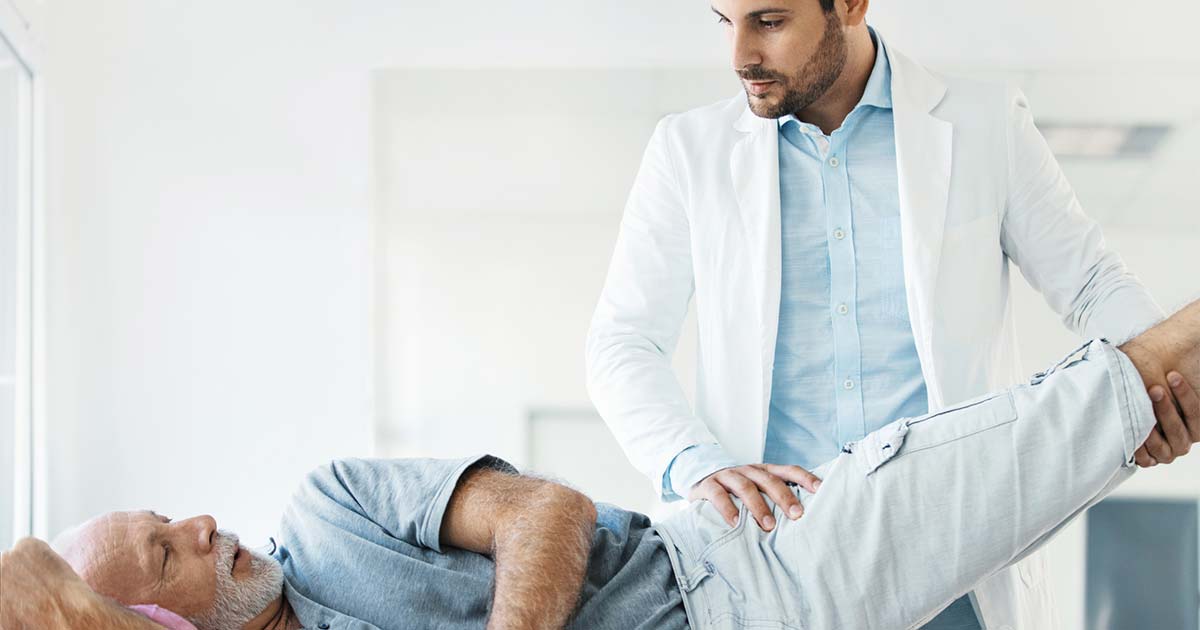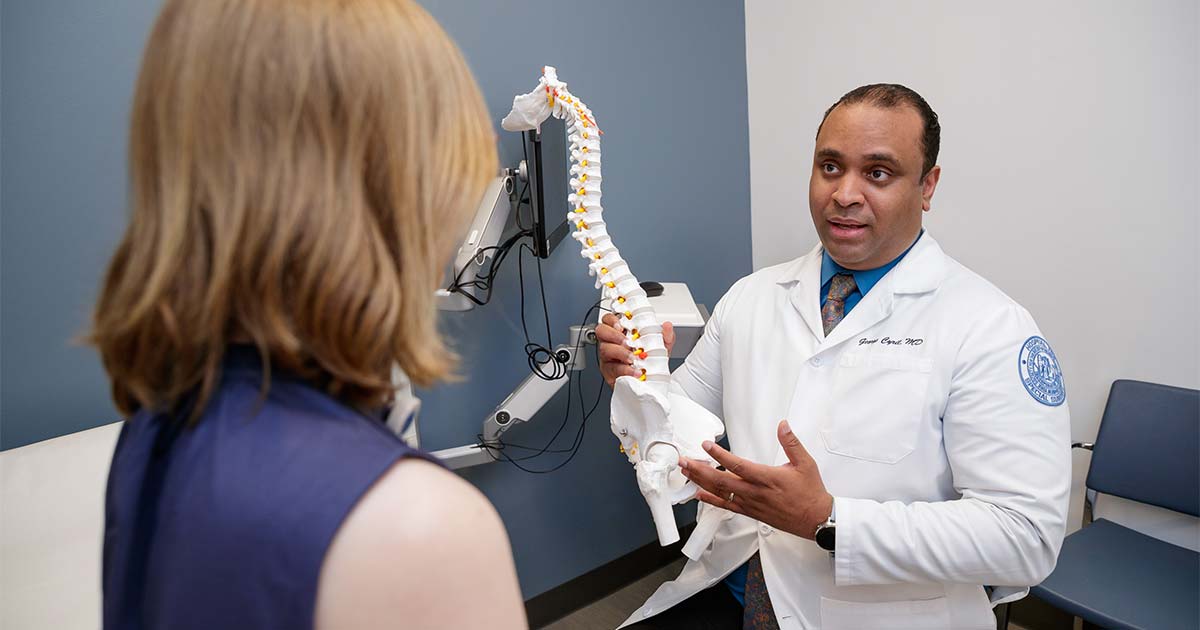Is Your Hip Popping? It Might Be Snapping Hip Syndrome
Advice to improve your movement, fitness, and overall health from the world's #1 in orthopedics.
“When a muscle or tendon slides over a bony bump in the hip, it can cause a snapping sensation that sounds like a pop,” says Brittany Popkin, a physical therapist at HSS.
While it may sound scary, snapping hip condition is usually more of a nuisance than an actual pain. However, if it persists and goes untreated, it could eventually lead to bursitis, an inflammation of the small sacs of fluid that help cushion the areas between tendons, ligaments and bones.

There are a few of types of snapping hip, depending on where the pop occurs, says Popkin.
- External snapping hip most commonly happens when the iliotibial band (a thick band of tissue on the outside of your thigh that extends from your hip bone to the top of your shinbone) slides over the greater trochanter (a bony bump on the side of the hip).
- Internal snapping hip most commonly happens as the iliopsoas (a group of three muscles that come together on the top of the thigh bone) slides over bony structures inside of the pelvis or femur.
Dancers, runners, soccer players and weightlifters are especially prone to snapping hip. “Anyone performing repetitive and extreme ranges of motion with their legs can be vulnerable,” says Popkin. Because they’re constantly putting their hips in flexion, then extension — by bringing the knees closer to then away from the chest — combined with rotation, the muscles and tendons in that area can get overworked and tighten up, she says.
The key to controlling snapping hip is to modify your activity, as well as to strengthen and stretch.
Popkin suggests starting at your core, which will take the pressure off your hip joints, as well as the gluteal muscles and hip abductors, which tend to be weaker in people with snapping hip syndrome.
Try the following to strengthen:
Abdominal Bracing
Focus on the transverse abdominus, which is one of the deep muscles in the core. “These are the foundational muscles that help stabilize your trunk and help it move in proper alignment,” says Popkin. To help you engage these muscles so you can fire them up when needed, perform an abdominal brace: Lie on your back with your knees bent. Inhale, then as you exhale, try to draw in the lower abs, engage the pelvic floor muscles and flatten your back into the floor. Don’t suck or squeeze, just keep breathing steadily. Do two to three sets of 10 reps with five-to-10 second holds.
Glute Bridges
- Lie on your back with your knees bent and feet firmly planted on the floor about shoulder-width apart.
- Perform an abdominal brace to maintain a neutral spine.
- Squeeze your glutes and imagine your heels moving toward your bottom.
- Initiating the movement from your glutes, push through your heels and lift your hips until your body makes a straight line from your shoulders to your hips to your knees.
- Pause at the top for a few seconds as you keep your glutes tightly squeezed. Do not use your back muscles with this movement.
- Slowly lower your hips back down and release your glutes.
- Do two to three sets of eight to 10 reps.
Sidestepping
- Get into a mini-squat position by pushing your butt back with your knees slightly bent.
- Step your right leg out to the right, then follow with your left leg.
- Make sure your knees don’t cave in and that the movement comes from the glutes.
- If you’d like to challenge yourself further, place a resistance band around your knees.
- Do two to three sets of five to 10 steps each way.
Side-lying Leg Lifts
- Lie on your right side with both legs straight, left leg stacked directly on top of the right. Check that your ears, shoulders, hips, knees and ankles make a straight line.
- Keeping your left leg straight, raise it off the right leg until you feel pressure in your core or lower back. Make sure not to tilt front or backwards. (Keep your hips stacked like bookends.)
- Lower the left leg back to meet the right leg. You want to make sure you feel this in your outside glute on the side of your hip. You don’t want to feel this in the front of your hip.
- Do two to three sets of eight to 10 reps on each side.
Try the moves below to stretch your hips. These can all be done throughout the day if your hips are very tight.
Half-Kneeling Hip Flexor Stretch
- Begin by kneeling on the floor.
- Bring your right leg in front of you so that your right thigh is parallel to the floor, with your knee bent at a 90-degree angle and your foot flat on the floor.
- Leave your left knee on the floor, making sure that your shin is pointing straight back (not toward the left or right).
- Put your hands on your hips, tilt your pelvis to keep your spine in a neutral position and squeeze your glutes.
- With your back straight, shift your weight forward until you feel a stretch through the front of the left thigh and groin. Do not lose your neutral spine as you do this weight shift.
- For an even deeper stretch, reach your left arm up overhead and slightly toward the right.
- Hold for 20 to 30 seconds. Do three to five times on each side.
Standing Iliotibial Band Stretch
- Stand up straight and cross your right leg in front of your left at the ankle.
- Raise your left arm overhead and reach it toward your right side. If you don’t feel steady, lean your left side against the wall or hold on to a chair or piece of furniture with your right hand. You should feel a stretch along your left hip.
- Hold for 20 to 30 seconds. Do three to five times on each side.
Figure 4 Stretch
- Sit on a chair and place both feet flat on the floor. You can also do this on the floor by starting with your legs extended.
- Lift your right leg and place your right ankle right above your left knee. If you’re on the floor, place your hands on the floor behind your back for support and keep your chest lifted.
- Gently lean forward while keeping your flat back. You should feel a stretch in the right glute.
- Hold for 20 to 30 seconds.
- Sit back up, return your right foot to the floor so you’re back in the neutral position and repeat the exercise with your left leg.
- If leaning forward is too much, you can gently push your knee down with your hand to get the same stretch.
- Do three to five times on each side.
Popkin also suggests plenty of foam rolling, a type of self-massage that can help loosen up the tight areas. Focus on the sides of your hip, quadriceps (in the front of the leg), glutes, IT band (along the side of the leg) and the adductors (on your inner thigh).
If you’re still experiencing snapping after you try these stretches and strengthening exercises, see a physical therapist. They can perform an evaluation and use additional techniques, including exercise prescription, activity modification and hands-on therapy.
Published 10/13/2022





